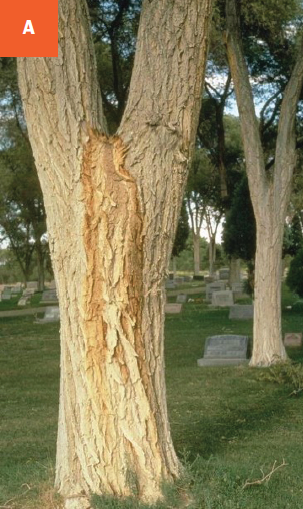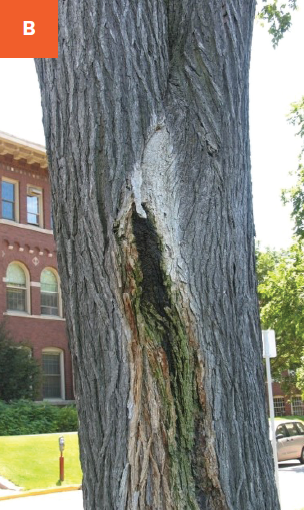Bacterial Wetwood or Slime-flux
Several species of bacteria including Enterobacter, Klebsiella, and Pseudomonas
HOST Aspen, cottonwood, elm, boxelder, maple, oak, linden, cherry, honeylocust, fir, poplar
DAMAGE/SYMPTOMS Bacterial wetwood often develops in the roots or the lower part of the trunk but may also affect branches. Affected trees may show discolored and water-soaked areas of the heartwood down the trunk, just below the area of infection. Infected wood may appear yellow, olive-green, or dark brown in color. The emitted sap may have a reddish or brown color and a foul odor. After drying up, the sap appears yellow, brown, or gray. Infections usually do not kill the tree but may inhibit wound healing.
DISEASE CYCLE Wetwood-causing bacteria live naturally in soil and water and infect trees through wounds. After initial infection, bacteria grow within their host, using the plant sap as a nutrient source and emitting gasses which are produced during fermentation processes. The build-up of gas pressure is released by discharging liquid through a branch crotch, pruning cut, or wound. The liquid is a mixture of the wetwood bacteria, yeast, and water.
MANAGEMENT No preventive treatments are available. The best management practice is to support plant health by providing adequate water and nutrients during the growing season and avoiding any wounding of plants. Branches affected by bacterial wetwood can be pruned out. Disinfect pruning tools between cuts with 70% ethyl alcohol or a standard household disinfectant spray.
A Bacterial wetwood on the main trunk. B Multicolored bacterial wetwood on main trunk. C Sap oozing out of an area of active wetwood.



